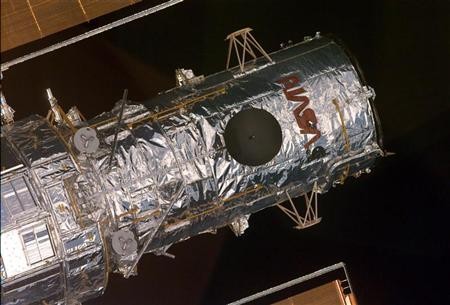NASA Set to Launch Successor of the Hubble Space Telescope
| Marco Foronda | | Apr 18, 2015 06:14 AM EDT |
(Photo : Reuters) The Hubble Space Telescope doing its job.
With Hubble Space Telescope celebrating the 25th anniversary of its launch into orbit this year, its successor is being prepped for action by the National Aeronautics and Space Administration.
Hubble's immediate successor is NASA's US$8.8 billion James Webb Space Telescope (JWST), which is due to launch in 2017. The infrared-optimized JWST will study the atmospheres of some nearby planets to be found by the Transiting Exoplanet Survey Satellite, or TESS, which NASA intends to launch in 2018.
Like Us on Facebook
The Webb, which is a joint project between US, European and Canadian space agencies, will be more powerful than the Hubble ever was, and will be able to see even further into the Universe. But nothing can erase the ground-breaking and scientific studies the Hubble has been a part of in its quarter century of service.
The Webb will be stationed far beyond the Hubble's low-Earth orbit. In fact, it's designed to sit far out from the Earth, past the moon, at a massive 932,000 miles from our plant. It's designed to have a deployable solar shield to block out light pollution from the Sun, the Moon and the Earth. This will enable the telescope to see even the faintest light coming from interstellar objects.
"A large sample of planets -- around 50 -- would have to be tested. Calculations show, for example, that if no biosignatures are detected in more than about three dozen Earth analogues, the probability of remotely detectable extrasolar life in our galactic neighborhood is less than about 10%," said Mario Livio, an astrophysicist based at the Space Telescope Science Institute in Baltimore, which operates Hubble's science program.
NASA is also developing a potential space-telescope mission called WFIRST/AFTA (short for Wide Field Infrared Survey Telescope-Astrophysics Focused Telescope Assets). WFIRST/AFTA, which could launch around 2024 if it gets the final go-ahead, would continue the search for biosignatures, among several other major tasks.
The Association of Universities for Research in Astronomy plans to release a report this June on such a potential telescope.
TagsNASA is Set to Launch Successor of Hubble Space Telescope, hubble, 25th Year Hubble, NASA, Space telescope, James Webb Space Telescope, space exploration
©2015 Chinatopix All rights reserved. Do not reproduce without permission
EDITOR'S PICKS
-

Did the Trump administration just announce plans for a trade war with ‘hostile’ China and Russia?
-

US Senate passes Taiwan travel bill slammed by China
-

As Yan Sihong’s family grieves, here are other Chinese students who went missing abroad. Some have never been found
-

Beijing blasts Western critics who ‘smear China’ with the term sharp power
-

China Envoy Seeks to Defuse Tensions With U.S. as a Trade War Brews
-

Singapore's Deputy PM Provides Bitcoin Vote of Confidence Amid China's Blanket Bans
-

China warns investors over risks in overseas virtual currency trading
-

Chinese government most trustworthy: survey
-

Kashima Antlers On Course For Back-To-Back Titles
MOST POPULAR
LATEST NEWS
Zhou Yongkang: China's Former Security Chief Sentenced to Life in Prison

China's former Chief of the Ministry of Public Security, Zhou Yongkang, has been given a life sentence after he was found guilty of abusing his office, bribery and deliberately ... Full Article
TRENDING STORY

China Pork Prices Expected to Stabilize As The Supplies Recover

Elephone P9000 Smartphone is now on Sale on Amazon India

There's a Big Chance Cliffhangers Won't Still Be Resolved When Grey's Anatomy Season 13 Returns

Supreme Court Ruled on Samsung vs Apple Dispute for Patent Infringement

Microsoft Surface Pro 5 Rumors and Release Date: What is the Latest?










